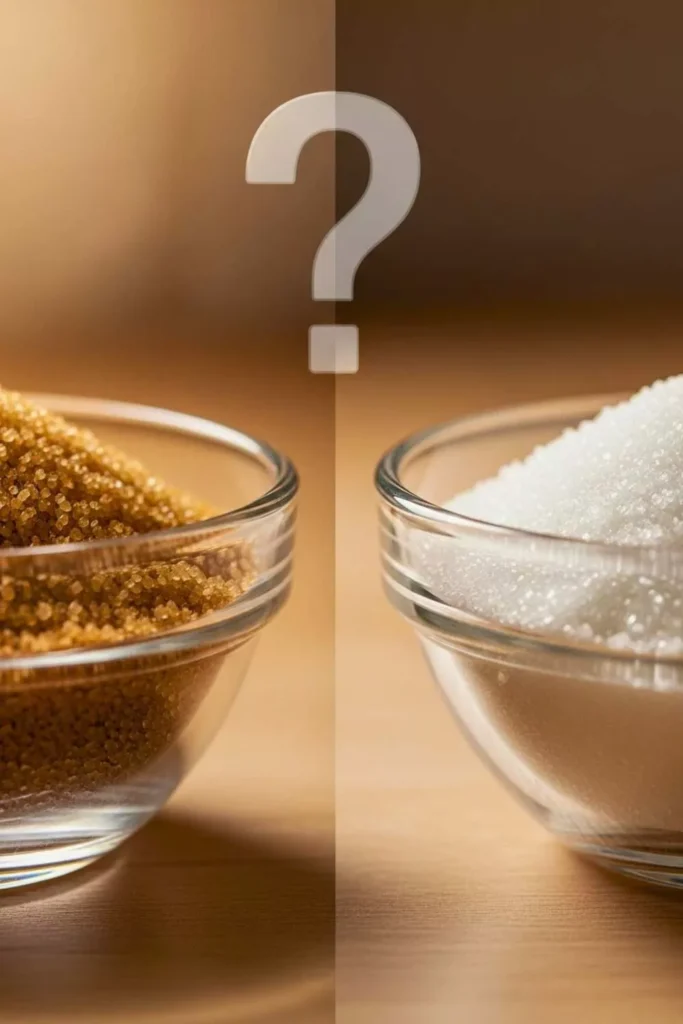When it comes to baking or cooking, sugar is more than just sweetness — it affects texture, color, and flavor. Many recipes call for brown sugar instead of white, but have you ever wondered why?
Let’s jump into the differences and discover when and why brown sugar can make all the difference in your kitchen.
What Is the Difference Between Brown and White Sugar?
Both brown and white sugar come from either sugarcane or sugar beets. The real difference lies in molasses — the rich, syrupy byproduct of sugar refining.
- White sugar has the molasses completely removed, leaving it pure, sweet, and neutral in flavor.
- Brown sugar retains some molasses (or has it added back in), giving it a richer color, deeper flavor, and more moisture.
There are two main types:
- Light brown sugar (around 3.5% molasses) — subtle flavor, great for cookies and cakes.
- Dark brown sugar (around 6.5% molasses) — stronger caramel flavor, ideal for sauces and spice-heavy recipes.

The Flavor Advantage: Depth and Warmth
Brown sugar brings a warm, caramel-like flavor that white sugar simply doesn’t have. This makes it perfect for:
- Cookies and muffins — adds that comforting, almost toffee-like taste.
- Barbecue sauces and glazes — creates a rich, smoky sweetness.
- Oatmeal or coffee — enhances flavor with a cozy molasses undertone.
White sugar, on the other hand, is cleaner and sharper in taste, which works well in recipes where you want the other flavors (like lemon or vanilla) to shine through.
The Texture Difference: Moisture Matters
The molasses in brown sugar adds moisture and softness to baked goods. That’s why cookies made with brown sugar are usually chewy, while those made with white sugar are crisp.
- Brown sugar retains moisture, keeping baked goods soft even after a few days.
- White sugar draws moisture out, creating a lighter, crunchier texture.
So if you’re after gooey brownies, chewy cookies, or soft cakes — brown sugar is your friend.
The Baking Chemistry: How Sugar Affects Texture and Color
Sugar doesn’t just sweeten; it also affects the structure of your baked goods.
- Brown sugar helps baked goods retain moisture and adds a denser crumb.
- Its molasses also promotes Maillard browning, giving your cookies or cakes a deeper golden hue and more complex flavor.
White sugar, by contrast, promotes a crispier edge and a lighter color.
Health Perspective: Is Brown Sugar Healthier?
Many assume brown sugar is the “healthier” choice. In truth, both are nutritionally very similar.
- Brown sugar contains trace minerals like calcium, potassium, and iron — thanks to molasses — but in such tiny amounts they don’t make a significant nutritional difference.
- Both provide the same calories and carbohydrate content.
So while brown sugar adds flavor and texture benefits, it’s not necessarily a healthier alternative.
When to Use Brown Sugar Instead of White
Here’s a quick guide:
| Recipe Type | Best Sugar to Use | Why |
|---|---|---|
| Cookies (like chocolate chip) | Brown sugar | Adds chewiness and depth |
| Cakes (like carrot or spice cakes) | Brown sugar | Enhances flavor and moisture |
| Meringues or macarons | White sugar | Keeps structure light and crisp |
| Sauces and marinades | Brown sugar | Creates caramelized richness |
| Simple syrups and frostings | White sugar | Keeps color and flavor clean |
Can You Substitute One for the Other?
Yes, but with small adjustments:
- Using brown sugar instead of white: Expect a moister, denser texture and a slightly darker color.
- Using white sugar instead of brown: Add 1 tablespoon of molasses per cup of white sugar to mimic the flavor and moisture.
Keep in mind that swapping sugars might change the texture and baking time slightly, so test it first if you’re aiming for perfection.
The Final Verdict
If you want rich flavor, chewy texture, and a golden hue, go for brown sugar.
If you prefer light, crisp, and neutral-tasting sweets, white sugar is your pick.
Both sugars have their place — but for a cozy, caramel depth in your baking or sauces, brown sugar adds that irresistible touch of warmth that white sugar can’t match.
In Short:
Use brown sugar instead of white when you want more flavor, color, and moisture. It’s not about being healthier — it’s about baking with heart and character.